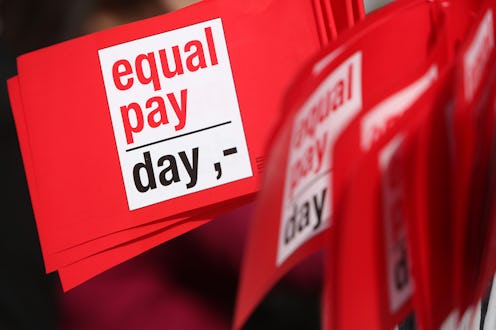
Every year, Equal Pay Day symbolizes the date women must work full time up until to make the same amount that men made working full time the year prior. In 2018, Equal Pay Day is on April 10, symbolically meaning that women had to work 99 days into 2018 to make the same amount that men made by Dec. 31, 2017.
Equal Pay Day was started by the National Committee on Pay Equity (NCPE) in order to raise awareness about the pay gap between men and women. According to Vox, in the United States women currently earn about 79 percent of what men do. As the NCPE reported on its website, April 10 does not constitute an exact calculation of how many days into 2018 women must work to earn men's 2017 wages. Rather, it represents a general symbolic representation. The day is symbolic because Census statistics that reveal 2017's wage figures are not available until August or September of 2018.
The NCPE always selects a Tuesday sometime in April for this symbolic day, because, according to the organization, Tuesdays also “represent how far into the next work week women must work to earn what men earned the previous week.”
There are several laws in the United States that mandate that women are paid the same amount as men for the same work. In 1963, during the Kennedy administration, Congress passed the Equal Pay Act, which banned inequitable compensation between men and women for the same job. And during the Obama administration in 2009, the president signed the Lily Ledbetter Fair Pay Act. The Act made changes to the statute of limitations for equal pay lawsuits, making it easier for women to sue their employers in cases of pay discrimination.
Despite these laws, however, pay inequity still very much persists — and is particularly detrimental for women of color. Indeed, a 2017 report from the Women's Bureau of the U.S. Department of Labor revealed that "In 2015, Hispanic women earned only 56.3 percent of the median weekly earnings of White, non-Hispanic men (the largest group of workers in the labor market), [and] Black women earned 61.2 percent."
If you are interested in helping close the gender wage gap, the National Committee on Pay Equity offers a variety of ways you can help do so. Its website provides several sample media advisories that you can send to your local news outlets to draw attention to the gender pay gap issue and encourages women around the country to start wage clubs. According to the NCPE, a wage club "allows women to gather regularly to participate in a series of discussions and strategy sessions to help each other take action to close the wage gap in their workplaces" The organization goes on to describe it as a "new grassroots movement" and offers specific guidelines on how to start one in your community.
This year, equal pay advocates faced a setback when the Trump administration decided to roll back an Obama-era law that required companies to report how much they were paying their employees by race and gender. According to NBC, the rule was intended to bring more transparency to company compensation practices in hopes of helping close the gender pay gap.
The Trump administration's decision to eliminate a rule designed to help close the gender wage gap means that fighting for equal pay is urgent. Hopefully 2018's Equal Pay Day will be one to remember.